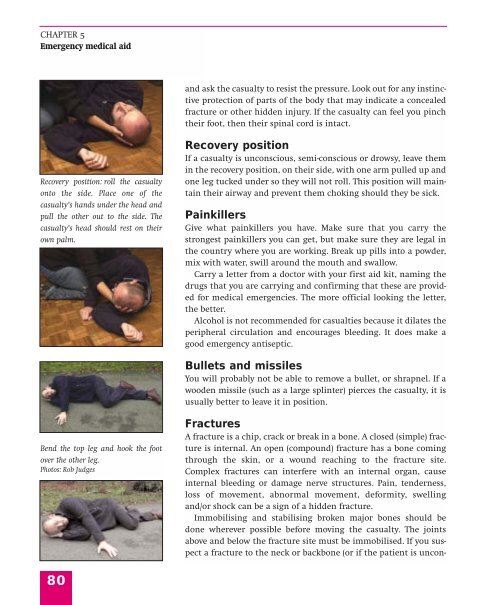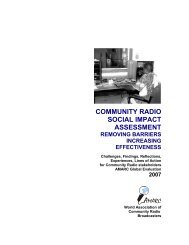Live News - A Survival Guide - International Federation of Journalists
Live News - A Survival Guide - International Federation of Journalists
Live News - A Survival Guide - International Federation of Journalists
- No tags were found...
Create successful ePaper yourself
Turn your PDF publications into a flip-book with our unique Google optimized e-Paper software.
CHAPTER 5Emergency medical aidand ask the casualty to resist the pressure. Look out for any instinctiveprotection <strong>of</strong> parts <strong>of</strong> the body that may indicate a concealedfracture or other hidden injury. If the casualty can feel you pinchtheir foot, then their spinal cord is intact.Recovery position: roll the casualtyonto the side. Place one <strong>of</strong> thecasualty’s hands under the head andpull the other out to the side. Thecasualty’s head should rest on theirown palm.Recovery positionIf a casualty is unconscious, semi-conscious or drowsy, leave themin the recovery position, on their side, with one arm pulled up andone leg tucked under so they will not roll. This position will maintaintheir airway and prevent them choking should they be sick.PainkillersGive what painkillers you have. Make sure that you carry thestrongest painkillers you can get, but make sure they are legal inthe country where you are working. Break up pills into a powder,mix with water, swill around the mouth and swallow.Carry a letter from a doctor with your first aid kit, naming thedrugs that you are carrying and confirming that these are providedfor medical emergencies. The more <strong>of</strong>ficial looking the letter,the better.Alcohol is not recommended for casualties because it dilates theperipheral circulation and encourages bleeding. It does make agood emergency antiseptic.Bullets and missilesYou will probably not be able to remove a bullet, or shrapnel. If awooden missile (such as a large splinter) pierces the casualty, it isusually better to leave it in position.Bend the top leg and hook the footover the other leg.Photos: Rob JudgesFracturesA fracture is a chip, crack or break in a bone. A closed (simple) fractureis internal. An open (compound) fracture has a bone comingthrough the skin, or a wound reaching to the fracture site.Complex fractures can interfere with an internal organ, causeinternal bleeding or damage nerve structures. Pain, tenderness,loss <strong>of</strong> movement, abnormal movement, deformity, swellingand/or shock can be a sign <strong>of</strong> a hidden fracture.Immobilising and stabilising broken major bones should bedone wherever possible before moving the casualty. The jointsabove and below the fracture site must be immobilised. If you suspecta fracture to the neck or backbone (or if the patient is uncon-80
















